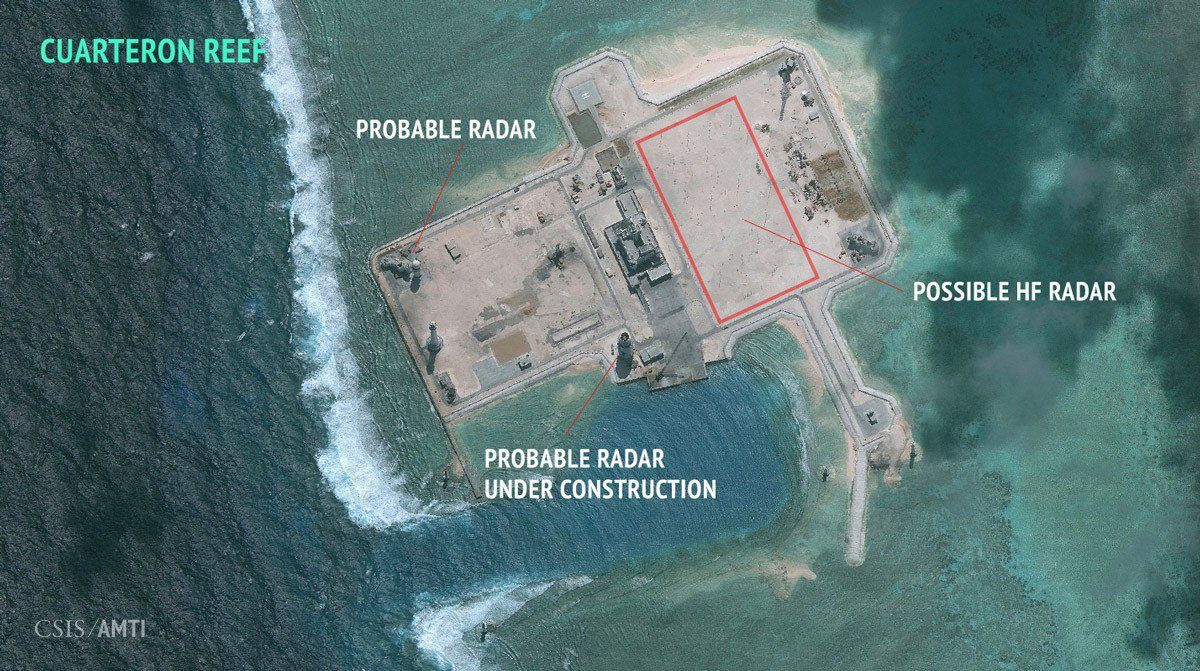SUMMARY
This is AI generated summarization, which may have errors. For context, always refer to the full article.

BEIJING, China (UPDATED) – Beijing is installing radar facilities on its artificial islands in the disputed South China Sea, an American think tank has said, in a move that could “significantly change” the operational landscape.
Satellite imagery of Cuarteron reef in the Spratly islands released by the Washington-based Center for Strategic and International Studies (CSIS) shows what appears to be a high-frequency radar installation, as well as a lighthouse, underground bunker, helipad and other communications equipment.
The photographs came only a week after US officials said China had deployed surface to air missiles in the Paracel islands further north, and with tensions mounting in the strategically vital region.
“Placement of a high frequency radar on Cuarteron Reef would significantly bolster China’s ability to monitor surface and air traffic coming north from the Malacca Straits and other strategically important channels,” said CSIS’s Asia Maritime Transparency Initiative.
Images of other small reefs nearby which China has transformed into artificial islands – Gaven, Hughes, and Johnson South – revealed other features identified by CSIS as probable radar towers, gun emplacements, bunkers, helipads, and quays.
CSIS said that while the earlier deployment of HQ-9 surface to air missiles was “notable,” it “does not alter the military balance in the South China Sea.”
But it went on: “New radar facilities being developed in the Spratlys, on the other hand, could significantly change the operational landscape.”
Beijing claims almost the whole of the South China Sea – through which a third of the world’s oil passes – while several other littoral states have competing claims, as does Taiwan.
The US has in recent months sent warships to sail within 12 nautical miles – the usual territorial limit around natural land – of a disputed island and one of China’s artificial constructions in what it says is a defense of the right to free passage.
The Chinese military has already been using the islands to monitor military and civilian traffic electronically but the new radar installations “will exponentially improve that capability,” said Euan Graham, director of the International Security Program at the Lowy Institute.
They would be highly vulnerable in conflict but would give China “a significant intelligence advantage – and make it much harder for the US and other regional navies and air forces to move through the South China Sea undetected,” he added.
Over-the-horizon radar is vital for missile targeting, he noted.
Military activities
Last week China confirmed it had placed “weapons” on Woody Island in the Paracels, defending what it said was its sovereign right to do so.
Asked about the radar installations, Chinese foreign ministry spokeswoman Hua Chunying said Tuesday that the area was Chinese territory “beyond dispute” and Beijing was entitled under international law to the “necessary and limited deployment of defence facilities.”
“Verbally, what the US talks about is freedom of navigation, but in its heart, perhaps what it’s thinking about is absolute hegemony on the sea,” she told a regular briefing.
Beijing says it defends the right to free passage, and insists its island building has civilian purposes, such as search and rescue facilities, as well as military.
A host of installations with potential military use are being developed, according to CSIS, including as many as 3 runways – at least one of them 3,000 meters (10,000 feet) long.
China is looking to deploy “all the defensive and offensive capability means that it has” as it seeks regional dominance, said Jean-Pierre Cabestan, of Hong Kong Baptist University.
“In view of the weaknesses of other claimants, China will be able to dominate and then potentially control the South China Sea – its main objective being to force the US Navy and Air Force to think twice before cruising or flying over the area,” he told AFP.
In the last 3 or 4 years, the Obama administration had become “more willing” to challenge Beijing’s claims in the South China Sea, said Lin Wencheng, of Taiwan’s National Sun Yat-sen University, adding: “The radar to some extent targets the US’s military activities in this region.”
Chinese foreign minister Wang Yi was heading to Washington on Tuesday for talks with US Secretary of State John Kerry, where the issue was expected to be on the agenda.
Kerry told reporters last week: “There is every evidence, every day, that there has been an increase of militarisation of one kind or another. It’s of a serious concern.” – Becky Davis, AFP / Rappler.com
Add a comment
How does this make you feel?
There are no comments yet. Add your comment to start the conversation.